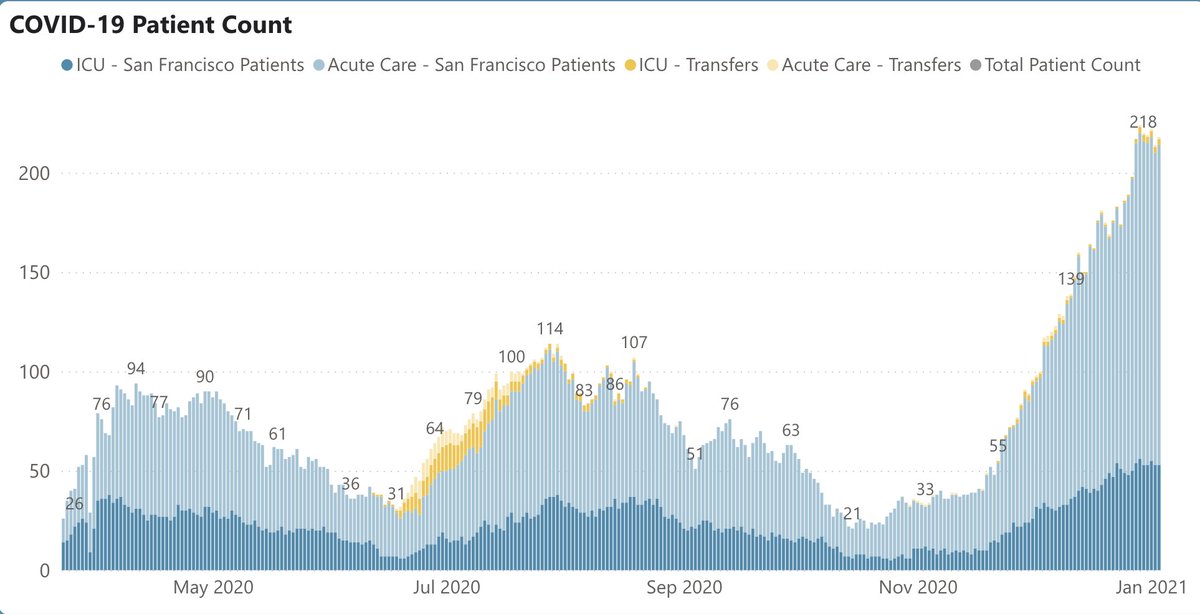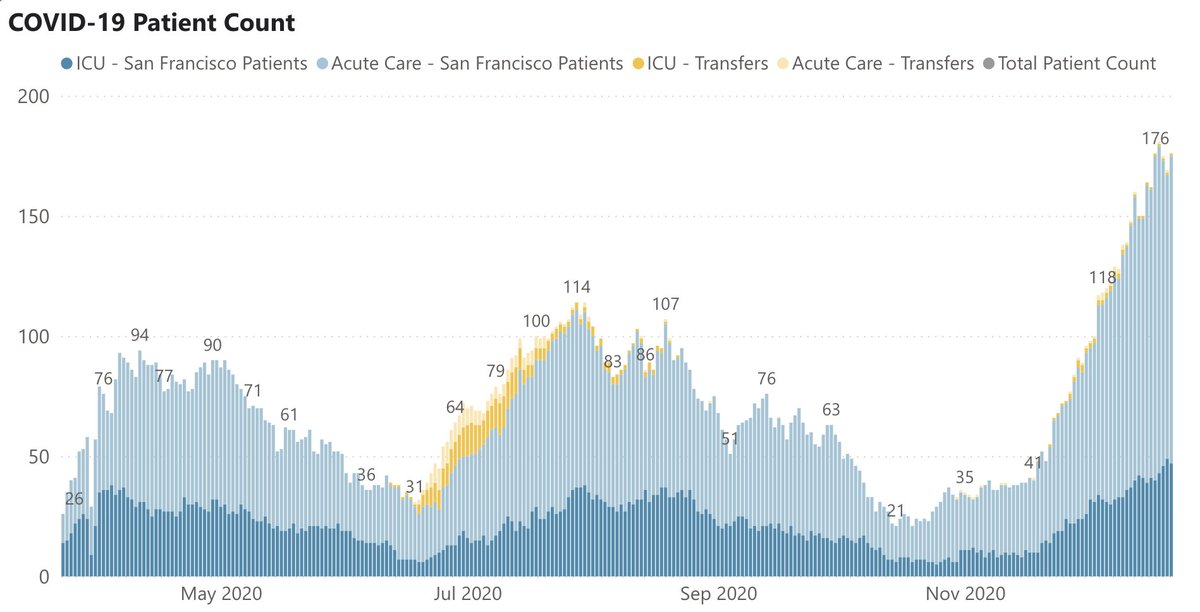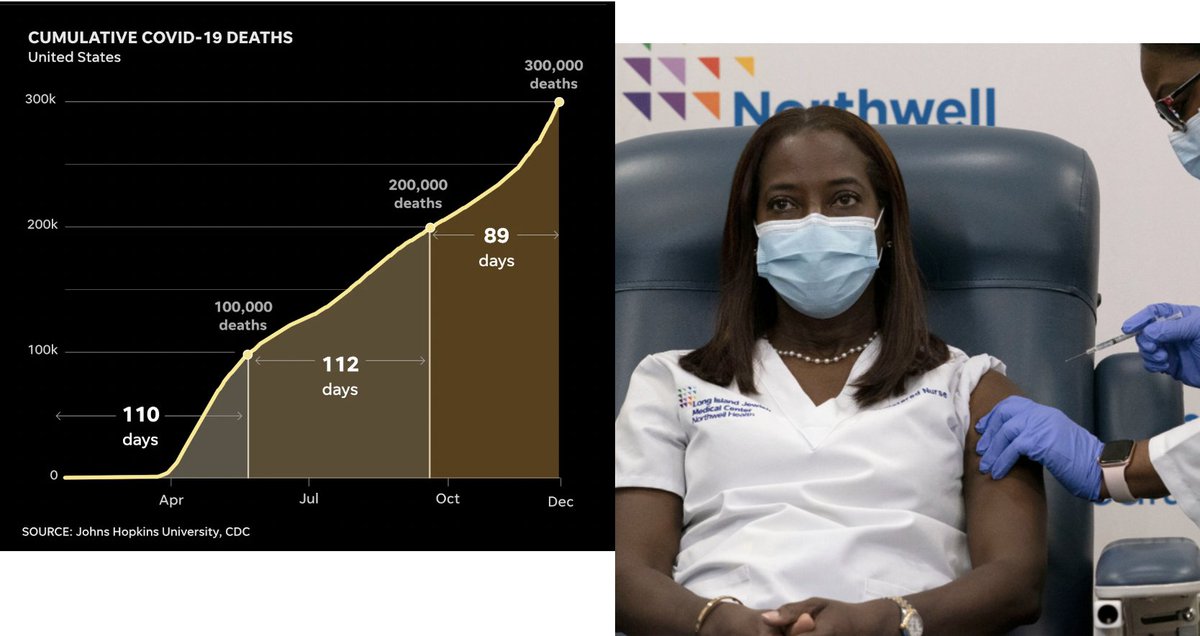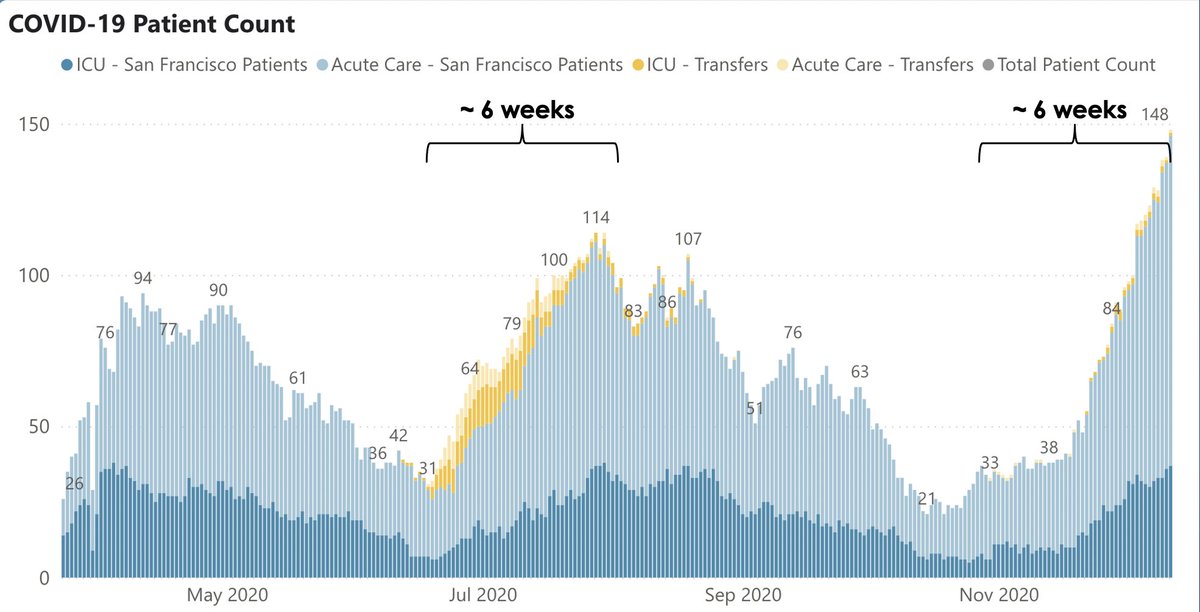
1/ Covid (@UCSF) Chronicles, Day 294
Lots to talk about, so today I’ll do an update on things @UCSFHospitals (now adding vaccine rollout), SF and CA. Then quick takes on a bunch of issues, mostly vaccine-related. The news is coming fast and furious – too much of it bad.
Lots to talk about, so today I’ll do an update on things @UCSFHospitals (now adding vaccine rollout), SF and CA. Then quick takes on a bunch of issues, mostly vaccine-related. The news is coming fast and furious – too much of it bad.
2/ Let’s start @UCSFHospitals, now having our biggest surge yet: 83 pts, 14 on vents (Fig L). It’s busy but it's not yet stressing our capacity in both hospital & ICU. Test positivity rate 5.1% overall – 16% (highest yet) in symptomatic pts; 2% (stable) in asymptomatics (Fig R). 



3/ Interesting that our hospital cases keep rising despite fewer new cases in SF – down to 237/day from peak of 290 (Fig L). But a worrisome new uptick – might be holiday/New Year’s effect. Test positivity rate pretty close to @UCSF’s: 4.49%. SF hospitalizations=218 (Fig R), w/… 



4/ …perhaps a little plateau. Overall, things are stabilizing a bit, though we need to be prepared for a post-holiday surge. Ditto for Bay Area, where cases and deaths look to have plateaued (Fig L). In CA, cases have also stabilized but deaths are still rising (Fig R)… 



5/ …largely driven by LA – now the West Coast version of NYC in March. I’m surprised by extent of LA's surge – despite pretty strict stay-at-home rules in CA & weather that forces no one inside for the winter. LA's diverse population & relative poverty (c/w SF) must be factors…
6/ …but individual behavior/choices must also play a role. Whatever the cause, LA’s stats are staggering (Fig). Note that # of new deaths in LA yest. (224) exceed deaths in SF since March (198). (LA is 11x larger by population.) Overall deaths per 100K people: LA 108, vs. SF 22. 

7/ Nationally, cases are still surging in lots of places (Fig L). And, after a bit of an improvement, we see that the nation as a whole, as well as all four regions, are heading in the wrong direction (Fig R). Amidst this bad news, we had hoped that vaccines would be our savior… 



8/ And they will be, but it’s been a rocky start. We’d hoped to have 20M people vaccinated by now. Instead, we just crossed 5M. We thought the bottleneck was going to be supply. But, at least so far, it's distribution: ~30% of the doses delivered in the U.S. have been injected.
9/ It varies by state (Fig from tinyurl.com/y7y9767j), w/ CA a laggard at 22.5%. Reasons for sluggish rollout vary (no cohesive national plan, not enough $ s [though $8B is coming soon], overwhelmed hospitals & public health systems...). Whatever – the result is unacceptable. 

10/ At @UCSF, doing relatively well. Here’s our vaccine dashboard (Fig) – kudos to our gr8 dashboard team, led by @RussCucina & @SaraMurrayMD. Subgroup A has greater potential Covid exposure; B has lots of pt-facing time but less Covid. Both include all workers, not just MDs/RNs. 

11/ Dashboard shows 99% of “A” has been offered 1st shot; 78% have received it. 93% of “B” offered; 47% have received it. Overall, 8,351 have received 1st dose, & invites are now going out to folks for 2nd doses. We’ll start on our elderly pts once done w/ our healthcare workers.
12/ Today @UCSF, vaccine is recommended, not required. Fairly small group is choosing to not get it (I suspect many are waiting & will get it later). We do require flu shots – I'm guessing once more time has gone by, we & others will require it for pt-facing workers. Seems right.
13/ On vaccines, my & @ashishkjha’s @washingtonpost op-ed has – as we hoped – contributed to a national conversation about the vaccination dosing plan tinyurl.com/y7c6v9hz Here’s my (long) thread on my take-homes from the dialogue so far: tinyurl.com/y2apj67v
14/ Am I disappointed @US_FDA announced yesterday that we should stick w/ approved protocol for now? tinyurl.com/y5dxn6un Maybe a bit, but not terribly surprised – would be big shift. Our goal was to promote debate & research, plus add a sense of urgency. Mission accomplished.
15/ One can find experts on both sides of the key variables (Will immunity wane? Will delay promote bad mutations? Will delay lead to folks failing to get shot 2? Will change in plan lead some to avoid vaccination at all?). One interesting new study @AnnalsofIM modeled standard…
16/ … strategy vs. delayed 2nd dose tinyurl.com/yy6xe6lk It came out strongly in favor of the delayed dose plan. But I’m sure one could put other assumptions into model & get different answers. (That’s the joy & curse of models.) Will continue to watch this debate play out.
17/ Another debate we need to have is over prioritization (who goes 1st, 2nd…) algorithms, which have become massively complex, operationally unworkable, & politicized. And we fear – in an effort to promote equity – they may do just the opposite. More to say on this in 1-2 days.
18/ The current surge & the slow vaccine roll-out are only 2 elements in the current Trifecta of Trouble. Element 3 is the mutated viral variant. While there have been only a handful of cases identified in the U.S., the fact that most of these had no travel-related risks means…
19/ … that the variant is already widely circulating in the U.S.; I suspect we’ll find hundreds of cases as we begin looking. While the virus itself is no more virulent, the fact that it is ~50% more infectious makes it far more concerning, since it means more cases, which…
20/ …will mean more serious cases & more deaths. It also means that the same activities that may have prevented Covid spread w/ “old virus” may fail with the new & improved one. So to be safe, think about being 50% more careful – an N95 (vs. a cloth) mask if you can snag one,…
21/ …8 feet instead of 6, fans inside, that sort of thing. This is the real deal. And it’s another reason why it’s crucial to hasten vaccine roll out – both to prevent illness & death in individuals, & to begin tamping down population susceptibility to the virus, both new & old.
22/ Sorry, there's more: a new variant, from South Africa, in which mutations seem to alter the shape of the spike protein – the target for vaccines – in ways that might compromise vaccine effectiveness (unlike the UK variant). tinyurl.com/y2qwvd8k Scary – watching closely.
23/ Before we get too bummed out about all this, it’s worth remembering that two months ago we didn’t know if we’d even have a vaccine that works, let alone two that are safe and 95% effective. And we didn’t know who our next president would be. So there’s that.
24/ Yet so far 2021 still feels an awful lot like 2020. Things should get better on Jan 20, & I suspect vaccine rollout will improve w/ experience. And a sense of urgency.
And for those following Georgia w/ interest & enthusiasm, stay calm & watch this: tinyurl.com/y24xsxr7
And for those following Georgia w/ interest & enthusiasm, stay calm & watch this: tinyurl.com/y24xsxr7
• • •
Missing some Tweet in this thread? You can try to
force a refresh









